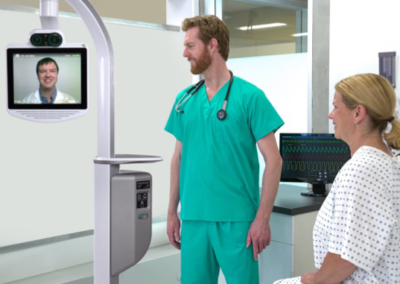‘It is safe, secure and IG-compliant, and I can use it to help make decisions about referrals.’
Professional-to-Professional Advice has been available in Tayside Health Board in Scotland since September 2018. The service, provided by Consultant Connect, connects clinicians with specialists for rapid advice and allows users to take IG-secure patient photos on their personal mobile devices.
We spoke with Dr Julie Donald, Clinical Lead for Emergency Medicine at Ninewells Hospital, Dr Rod Fleming, GP at Erskine Practice, and Kirsty Wilkinson, a Nurse at the Minor Injury Unit at Blairgowrie Community Hospital, to provide a holistic view of how the service operates and benefits all involved.
Dr Donald answers calls from local clinicians to provide Prof-to-Prof Advice and streamline the patient discharge and admission process.
‘One of the main strengths of this service is that junior doctors working in ED can speak to their senior consultant colleagues before admitting or discharging a patient. This prevents inappropriate admissions and discharges. By streamlining the process in this way, we can provide a safer discharge process whilst ensuring that NHS resources are correctly allocated to those who need them most. This improves patient care and reduces strain on the department.
We can cover aspects such as patient management, review imaging and advise on which specialty to which a patient should be referred. We can do all this safely, knowing that calls are recorded so that, if ever required, we can identify and interrogate the calls via the Consultant Connect system.
We can provide advice to paramedics and GPs as well so that we can improve the patient experience and reduce A&E waiting times. We will often suggest alternative outcomes or services that may be more appropriate for patients than coming to ED. This is especially beneficial for frail elderly care-home patients.’
Dr Fleming thinks that Telephone Prof-to-Prof Advice is a good tool and says:
‘I can directly call the most appropriate specialty, usually answered by a consultant, which frees up time for the hospital and switchboard service. This is better than previous methods, which would have involved bleeping the on-call consultant via switchboard. It’s very useful to get advice on any patient you think may or may not need admission or specialist opinion.’
Kirsty Wilkinson uses the Consultant Connect App to take IG-secure images of patients’ dermatological issues:
‘It’s safe, secure and IG-compliant, and I can use it to help make referral decisions. We also use this feature for staff training as it was recognised that a staff member’s Steri-Strip techniques could be improved after discussing a photo of a patient and available techniques used.’
Patient Examples
Kirsty Wilkinson
‘A patient under my care was suffering from a leg ulcer which was taking a very long time to heal. The patient felt that the wound was not healing at some points. The patient had become low in mood as the wound was malodorous. I could track the patient’s progress by taking photos of the condition.
After some time, I could explain the healing process to the patient. The photo progression allowed me to show the approach to the patient, even if it was slow. This really benefitted the patient as it improved her mental health. It also allowed a detailed handover to a team member for holiday cover.’
Dr Fleming
‘A 27-year-old patient presented with a one-week history of flu-like symptoms with a dry cough, vomiting and left-sided chest pain. She was noted to be pyrexial and tachycardic but had a normal-sounding chest and O2 saturations. I suspected it was either community-acquired pneumonia or influenza and wanted to request an urgent CXR.
I called Acute Medicine via Consultant Connect and spoke to a local consultant who agreed that if the patient attended hospital, they would look at the CXR on PACS and call the patient with the results.
The patient was prescribed antibiotics in case of pneumonia, but the CXR did not show any initial changes, though the radiologist did report signs of possible pneumonia. Using Prof-to-Prof Advice meant the patient was managed in the community, avoiding needing a hospital appointment.’




